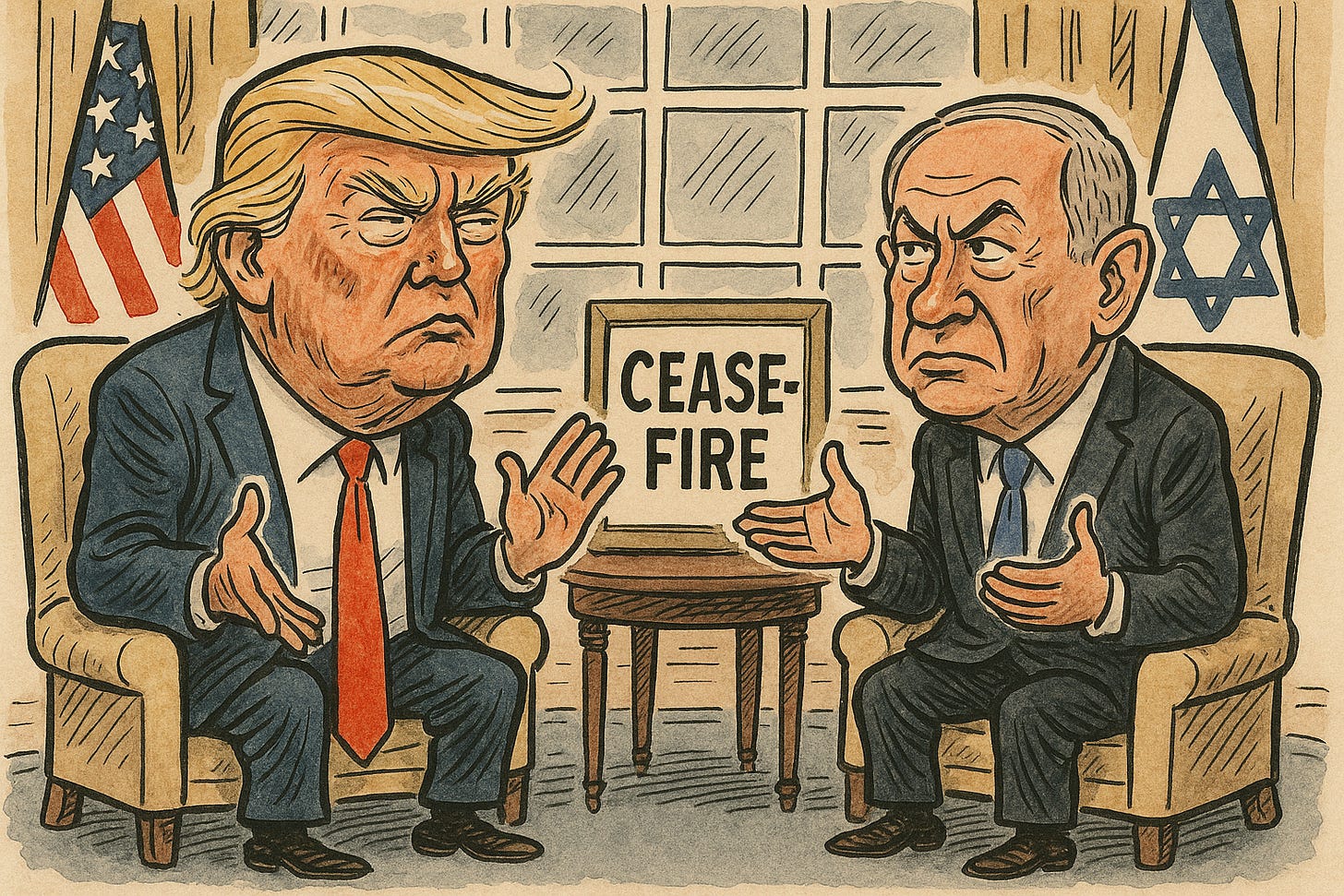Sensei's Morning Forecast: Trump’s Tariff Deadline Rattles Markets as Musk Launches Party, Bitcoin Eyes $150K
As Trump’s tariff threat nears execution, Musk launches third party, Tesla stumbles, XRP awaits decision, BRICS falters, and markets brace for geopolitical and economic realignment.
👋 A Quick Recap — And a Warm Welcome to New Joiners
If you're new here, welcome to the upgraded Martyn Lucas newsletter!
And if you’ve been reading for a while, here’s a quick refresher on what you now receive each trading day:
✅ The 5 most important things to know before markets open
📉 Chart of the Day with key levels and technical context
🧠 Deep Dives into the big stories moving stocks and crypto
🚀 Coverage of emerging trends like AI, eVTOL, BRICS & macro shifts
📬 If this landed in your junk or promotions folder, make sure to move it to your inbox so it arrives reliably every morning before the bell.
Our goal is to make this the most useful market read of your day — clear, actionable, and built to sharpen your thinking.
If you're still on the free version, you're only seeing part of the picture.
Start your free 7-day trial and unlock the full experience:
🔓 Full daily briefings
🔓 Premium chart setups
🔓 Exclusive research and deep dives
🔓 Access to the full archive
🔓 Member Q&A, chart room, and exclusive groups
👉 Start Your Free Trial Now
Enjoy the rest of today’s newsletter — and see you in tomorrow’s issue,
– Sensei
🧠 One Big Thing
President Trump’s threatened 10% tariff on BRICS-aligned nations targets over 40% of global GDP—marking the most aggressive trade stance since WWII. With the new August 1 deadline looming, the global investment map is being redrawn around political alignment, not just profits.
💰 Money Move of the Day
Bitcoin’s bull flag structure points to a $150K target if momentum carries through, while XRP is hovering just below $2.30 as speculation swirls around a potential SEC case withdrawal.
📊 Market Snapshot
Cryptocurrencies:
Bitcoin (BTC): $108,706 (▼ -0.48%)
Ethereum (ETH): $2,559 (▼ -0.49%)
XRP: $2.28 (▲ +0.58%)
Equity Indices (Futures):
S&P 500 (SPX): 6,260 (▲ +0.49%)
NASDAQ 100: 22,966 (▼ -0.42%)
FTSE 100: 8,835 (▲ +0.51%)
Commodities & Bonds:
10-Year US Treasury Yield: 4.360% (▲ +0.28%)
Oil (WTI): $67.66 (▲ +0.55%)
Gold: $3,301 (▼ -0.74%)
🕒 Data as of
UK (BST): 12:00 / US (EST): 07:00 / Asia (Tokyo): 20:00
✅ 5 Things to Know Today
🇺🇸 One Big, Beautiful Bill Passes
What Is It?
A sweeping tax-and-spending law signed by former President Donald Trump on July 4, 2025, at a campaign-style rally in Houston—framed as an “America First” economic reset. Dubbed the “One Big Beautiful Bill,” it locks in Trump’s 2017 tax cuts, expands credits for tips, overtime, child, education, and adoption, and delivers a 1% remittance tax.
The bill passed through Congress via the budget reconciliation process—crucial for bypassing the Senate filibuster. The Senate approved the final version 51–50, with Vice President J.D. Vance casting the tie-breaking vote after a marathon amendment session (AP, CBS). The House followed with a narrow 218–214 vote, secured by intense leadership negotiation and overcoming two GOP defections (The Guardian). This legislative victory marks a significant moment in President Trump’s second-term agenda, consolidating his influence within the Republican Party structure.
Main Changes
Taxes: 2017 Trump tax cuts made permanent; no federal tax on tips or overtime (under $150k); Child Tax Credit doubled; SALT cap raised (BBC, Wikipedia).
Spending: $175B for border security; $160B increase for defence; deep Medicaid cuts; stricter SNAP work requirements; clean-energy tax credits eliminated (Al Jazeera, FingerLakes1).
Other: No taxes on Social Security; expanded education and adoption credits; 1% remittance tax; student loan subsidies rolled back (BBC).
Who Gains, Who Risks Losing
Gains: Wage earners, families, retirees, and defence and border sectors (Defence Industry Europe).
Risks: Low-income Americans (Medicaid cuts), SNAP recipients, clean-energy firms, state budgets, and hospitals bracing for a rise in the uninsured (NatLawReview, LeadingAge).
Why It Matters
The “One Big Beautiful Bill” marks a pivotal shift in U.S. fiscal policy with wide-reaching sector impacts. Permanent tax cuts and exemptions for tips, overtime, and Social Security could lift disposable income, support consumer sectors, and benefit service-heavy employers. Defence contractors are likely to be the winners amid the $160 billion military boost. But Medicaid cuts and the rollback of clean-energy incentives threaten hospital balance sheets and renewable project pipelines. States may face widening budget gaps as federal support shrinks. With deficits projected to surge by $3–5 trillion, Treasury yields could rise, steepening the curve and pressuring credit-sensitive equities. Markets may rotate out of rate-sensitive growth sectors into defence, consumer cyclicals, and near-term stimulus plays (Al Jazeera, Tax Foundation).
Sensei’s Insight: This bill isn’t just about tax cuts or spending lines—it’s a structural signal. When government policy leans this hard into defence and consumption while pulling back on healthcare and energy transition, capital doesn’t just follow—it reprices. Investors should be thinking less about what rallied today and more about what the funding stress, fiscal direction, and sector reallocations mean over the next six quarters. Watch the curve, watch the coverage ratios, and stay nimble where the subsidy floor just vanished.
🚨 Trump vs. Musk: Political Alliance Explodes
Elon Musk and Donald Trump—once allies—are now in open warfare. Musk, who led the Department of Government Efficiency in Trump’s cabinet, broke ranks after the “One Big Beautiful Bill” slashed EV credits and expanded the deficit. Trump called Musk a “train wreck,” accusing him of acting out of personal financial interest. Musk hit back hard, accusing Trump of “waste & graft” and threatening to unseat GOP lawmakers who backed the bill (Fox 5).
🗳️ The America Party Launches
On July 6, Musk unveiled the America Party, pledging to challenge the two-party system. He won’t run for president but plans to target 2–3 Senate races and 8–10 House districts in 2026—enough to block either party from gaining a clean majority. He says the goal is to force accountability through coalition governance. A poll on X showed 2-to-1 support among 1.2M users for a third party.
📉 Tesla Slides, Political Fallout Mounts
Tesla stock dipped following Trump’s threats to investigate Musk’s federal contracts—but investor unease also reflects deeper concerns. Musk’s renewed political crusade comes just as regulatory scrutiny builds around Tesla’s pending robotaxi rollout, raising fears he’s once again distracted at a critical moment. Some Republican operatives warn the America Party could siphon off votes in key districts, while analysts frame the feud as a more profound political rupture—with potential ripple effects across tech, energy, and campaign finance as two of the most influential figures in U.S. politics collide (Reuters, Newsweek).
Why It Matters
The Trump–Musk feud is more than a personality clash—it’s a structural fracture inside the conservative base. With the Republicans already navigating internal divides post-bill passage, the emergence of Musk’s America Party raises the threat of third-party vote splitting in razor-thin races. Markets are watching closely: Tesla’s pullback and talk of federal contract reviews signal that the clash could move beyond politics into regulatory and financial risk. The 2026 midterms just became far more unpredictable, especially in purple districts where a few thousand votes could now shift control of Congress.
Sensei’s Insight: This is where disruption gets institutional. Musk isn’t just threatening the GOP—he’s stress-testing the system. If even a few of his candidates win, legislative math changes overnight. Investors should treat this less like a culture war and more like a control risk: expect higher volatility in defense, clean energy, and regulatory-sensitive tech. Watch which incumbents quietly shift tone—those are your tells for how seriously Washington is taking this.
Rio Rift: BRICS Expands, but Unity Falters Amid Tariff Threats
The 17th BRICS Summit is underway in Rio through July 7, with early outcomes including the Rio Declaration signed by all 11 member states—welcoming Indonesia and endorsing 126 initiatives across global governance, climate finance, and AI (Reuters). Brazil’s presidency secured a climate finance framework, an AI pact, and a health partnership on disease elimination. The New Development Bank reported $40B in climate-related investments and reappointed Dilma Rousseff as president. Ministers also backed a proposed BRICS Multilateral Guarantees mechanism to reduce investment risk in the Global South.
Progress remains sluggish on cross-border payment systems, and geopolitical fractures were evident. Chinese President Xi Jinping sent Premier Li Qiang in his place, while Russian President Vladimir Putin participated virtually due to ICC warrants—marking the first time the original BRIC leaders were not physically present. The group condemned Israeli actions in Gaza, called for an “immediate and unconditional ceasefire,” and reaffirmed support for a two-state solution, but Iran’s absence exposed internal rifts. Meanwhile, Trump threatened a 10% tariff on countries aligning with BRICS’ “anti-American policies,” with tariff letters expected by July 9. The move targets nations representing ~40% of global GDP and injects fresh risk into the emerging market outlook. Expansion talks also progressed, with Algeria, Colombia, and Uruguay under consideration for NDB membership.
Sensei’s Insight: BRICS’ expansion—now at 11 members with Indonesia—demonstrates growing institutional ambition, marked by joint commitments on climate finance, AI regulation, and health security. But unity is fraying: Xi and Putin are absent in person, and while leaders condemned Israeli operations in Gaza and called for a two-state solution, they stopped short of deeper geopolitical alignment. President Trump’s threatened 10% tariffs add a new layer of volatility to the emerging‑market landscape.
💹 BTC Hits Record Weekly Close, XRP Awaits SEC Decision
₿ Bitcoin: Highest Weekly Close Ever + Mega Bull Flag ($150K Target)
BTC closed the week above $109,000—its highest weekly candle ever—and continues to consolidate above key resistance in a textbook bull flag formation. Technical analysts now point to a breakout target of $150,000 if BTC clears the $110K zone with volume (Investing.com, Cointelegraph). The macro backdrop—including fiscal stimulus from the “Big Beautiful Bill”—is seen as supportive. All eyes now on volatility as traders brace for the next leg.
⚖ XRP: Legal Resolution Looms, ETF Buzz Builds
XRP is hovering near $2.30, a key level of resistance. Expectations are that if this level breaks, a surge to $2.62 is next. Ripple has dropped its cross-appeal, and speculation is rising that the SEC will formally withdraw its own appeal after the agency’s closed-door meeting on July 10 (FXEmpire, Reuters). Meanwhile, Grayscale’s ETF now includes XRP, fueling optimism for a dedicated spot product in Q3 (CCN).
Ξ Ethereum & Altcoins: Heavy ETF Inflows Signal “Altcoin Summer”
Ethereum led inflows with $1.17 billion into spot ETH ETFs in June—its strongest month yet—with institutional momentum expected to reach $10 billion by end‑2025 (AInvest, CoinWorld via SoSoValue). Stablecoin activity and tokenization trends bolster ETH’s utility, while inflows into altcoin ETFs (Solana, Cardano, etc.) hint at a broader summer rally (Cointelegraph).
🧭 Market Themes to Watch
Institutional Rotation: BTC ETF flows slowed to start July, while ETH and altcoin ETFs are accelerating. Flows suggest growing appetite for diversification and risk exposure beyond Bitcoin (AInvest).
Macro Liquidity Tailwinds: The “Big Beautiful Bill” is seen as injecting fiscal stimulus into the system—potentially lifting digital assets in a lower-yield, high-liquidity environment (Finance Magnates).
Regulatory Catalysts: XRP’s SEC case resolution and spot ETF decisions for XRP, SOL, and ADA remain top July catalysts. A formal SEC withdrawal on July 10 could trigger a wave of institutional repositioning (FXEmpire, Cointelegraph).
Sensei’s Insight: New highs mean nothing without follow-through. BTC’s weekly close sets the stage, but $110K is the gate. XRP’s path hinges on July 10—clear that, and momentum could shift fast. ETH inflows show where institutions are already leaning. Watch rotation, not headlines.
🕊️ Washington Sets the Stage for Postwar Gaza Talks
Israeli Prime Minister Benjamin Netanyahu’s strategic adviser Ron Dermer held high-level meetings in Washington with Vice President JD Vance, Secretary of State Marco Rubio, and Middle East envoy Steve Witkoff to lay the groundwork for Gaza’s postwar governance (Axios, Azure Strategy, Politico). These consultations took place ahead of Netanyahu’s expected meeting with former President Donald Trump today at the White House; Netanyahu landed in Washington yesterday (Reuters, NYT). Discussions with U.S. officials focused on eliminating Hamas from Gaza while establishing an international mechanism to oversee the territory’s reconstruction and administration (Axios, Azure Strategy). Israeli UN Ambassador Danny Damon reiterated that Israel does not intend to permanently occupy Gaza, but plans to retain security operational capabilities similar to those used in the West Bank (UN Press, BBC).
These pre-summit talks mark a pivotal moment in regional diplomacy and potential economic recalibration. The emerging framework aims to channel Gaza’s estimated $27 billion reconstruction through international oversight, supported by Gulf and European donors, while preserving Israeli counterterrorism access (Israel Policy Forum, PassBlue). Markets have responded to signs of progress, with Israeli defense and infrastructure stocks particularly buoyed by the potential for long-term stability. The model under discussion could unlock major investments in construction, telecommunications, and energy, while helping reduce the geopolitical risk premium imposed on regional assets since the outbreak of war on October 7, 2023 (Wilson Center, Washington Institute).
Sensei’s Insight: High-level U.S.-Israel talks in Washington are laying the foundation for Gaza’s reconstruction and security model, just as Netanyahu prepares for direct White House negotiations with Trump. Investors should track momentum toward international governance—billions in infrastructure and regional development capital may follow.
🔗 Connect with Us
Stay plugged in across platforms:
Sensei on X: sensei_crypto_
Martyn Lucas on X: MartynInvestor
Vaz on X: eVTOLHUB
💎 Premium Discord Access: Join the Discord
📺 YouTube Channel (Live & Replays): Martyn Lucas Investor
👕 Limited Merch: Shop Here
🔍 Deeper Dive: Tariff Trigger: How Trump’s August 1 Deadline Redraws the Investment Map 🇺🇸
President Trump’s global tariff threat is more than a headline—it’s a structural pivot. The August 1 deadline transforms a policy threat into an economic inflection point, marking the most aggressive U.S. trade posture since WWII. Investors must now assess not just financial fundamentals, but geopolitical alignment and supply chain exposure.
Keep reading with a 7-day free trial
Subscribe to Sensei’s Insights to keep reading this post and get 7 days of free access to the full post archives.











